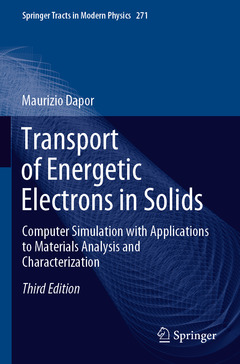Description
Transport of Energetic Electrons in Solids (3rd Ed., 3rd ed. 2020)
Computer Simulation with Applications to Materials Analysis and Characterization
Springer Tracts in Modern Physics Series, Vol. 271
Author: Dapor Maurizio
Language: English
Support: Print on demand
Description
/li>Contents
/li>Biography
/li>Comment
/li>
This book describes, as simply as possible, the mechanisms of scattering (both elastic and inelastic) of electrons with solid targets (electron?atom, electron?plasmon, and electron?phonon interactions). It also presents the main strategies of the Monte Carlo method, as well as numerous comparisons between simulation results and the experimental data available in the literature. Furthermore it provides readers with all the information they need in order to write their own Monte Carlo code and to compare the obtained results with the many numerical and experimental examples presented throughout the book.
An extended and updated third edition of a work published in 2014 (first edition) and in 2017 (second edition) on the application of the Monte Carlo method to the transport of fast electrons in solids, this book includes, as novel topics, the theory of polarized electron beams (i.e. density matrix and spin polarization), the study of elastic scattering by molecules, a classical treatment of the Bethe-Bloch stopping power, a simple derivation of the f- and ps-sum rules, the Vicanek and Urbassek formula for the calculation of the backscattering coefficient, the Wolff theory describing the secondary electron spectra, and fundamental aspects of the interactions between electrons beams and solid targets. Further, it describes a completely analytical approach (the so-called multiple reflection method) for calculating the absorbed, backscattered, and transmitted fractions of electrons from unsupported and supported thin films. It also discusses recent applications of the Monte Carlo method.Chapter 1 - Electron transport in solids.-
Chapter 2 - Computational minimum.-
Chapter 3 - Cross-sections. Basic aspects
Chapter 4 - Scattering mechanisms
Chapter 6 - Monte Carlo strategies
Chapter 7 - Electron beam interactions with solid targets and thin films
- Basic aspectsChapter 8 - Backscattering coefficient
Chapter 9 - Secondary electron yield
Chapter 10 - Electron energy distributions
Chapter 11 - Applications
Dr. Maurizio Dapor is the Head of the Interdisciplinary Laboratory for Computational Science of the European Centre for Theoretical Studies in Nuclear Physics and Related Areas (ECT*-LISC). He holds a M.Sc. degree in Physics and a Ph.D. degree in Materials Science and Engineering. His research covers Monte Carlo simulations of the transport of fast electrons in solids, with applications to the scanning electron microscopy and to several electron spectroscopies. He was Visiting Professor at the Departamento de Física Aplicada, Universidad de Alicante, from April to June 2016, and Leverhulme Visiting Professor at the Department of Materials Science and Engineering at the University of Sheffield from December 2014 to November 2015. He was a Scientific Consultant at the Integrated Systems Laboratory of the Swiss Federal Institute of Technology (ETH), Zurich, from January to December 2009, and a Research Associate at the University of Sheffield’s Department of Engineering Materials from June 2007 to February 2008. He is a Senior Scientist at the Fondazione Bruno Kessler. He collaborates with the University of Trento’s Department of Physics, where he was an Adjunct Professor of Solid-State Physics from 2011 to 2015 and is currently an Adjunct Professor of Computational Methods for Transport Phenomena. He holds the Italian National Scientific Habilitation to Full Professor in Theoretical Physics of Matter and in Experimental Physics of Matter. He is the author/co-author of more than 120 reviewed scientific papers and of several books.
Describes the Monte Carlo strategies used for simulating the transport of charged particles in solid targets in great detail
Provides a way of calculating all the cross sections necessary to the Monte Carlo code
Includes numerous comparisons of results of the Monte Carlo simulations with the available experimental data




